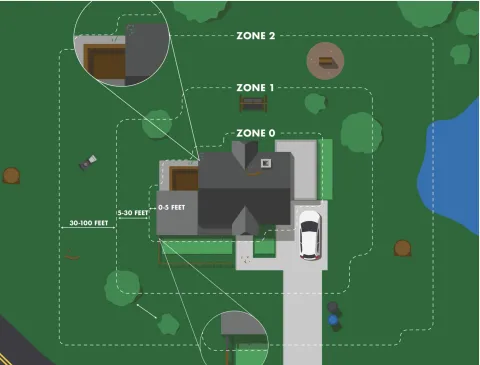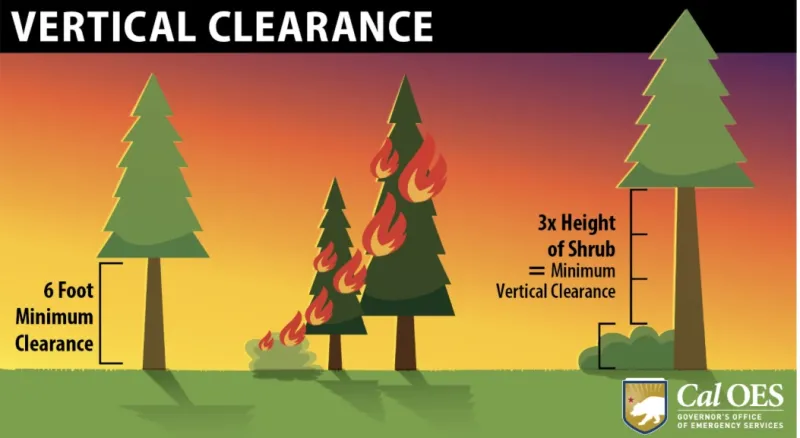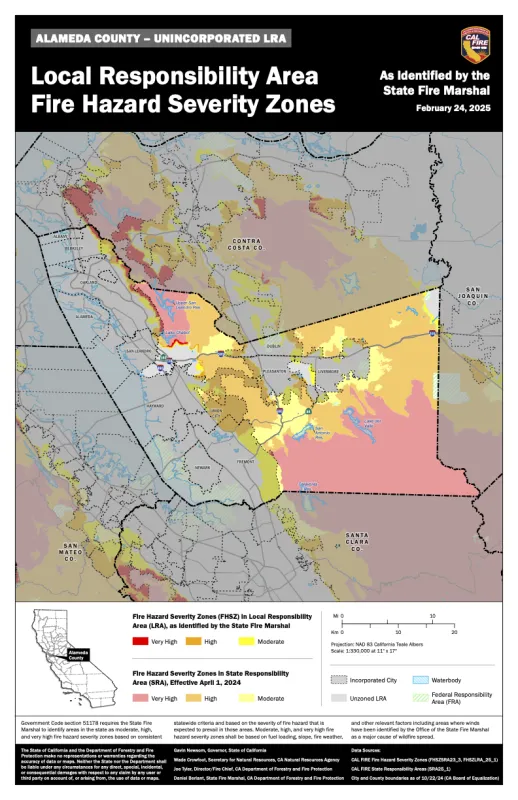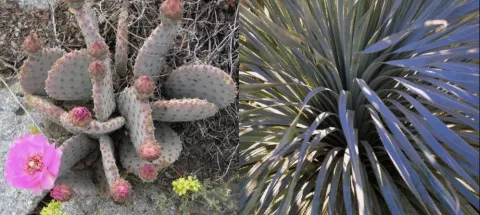In the last few years fire safety in California has become an important issue for gardeners due to the increase in the number and size of wildfires that have burned hundreds of thousands of acres and destroyed thousands of homes. The dangers of wildfires can be extreme, both at the wildland-urban interface, and even in the middle of large cities as the Los Angeles fires of 2025 and even the smaller Keller fire in Oakland in 2024 have shown us. Moreover, the incidence of wildfires is only likely to increase in the future. While we all want to grow lush and beautiful landscapes, achieving this can often bump up against best practices for fire safety.
This blog is focused primarily on Alameda County. It reviews scientific and fact-based information to help gardeners understand how best to protect their gardens and homes from wildfire damage. It also highlights issues that can limit the success of those efforts. Fire risk maps for many California counties were updated in 2024 and early 2025, including some changes in the definitions of moderate, high, and very high risk areas. You can search with your address to find the 2024 wildfire risk level of your property on the Alameda County map at Wildfire zone map. Some general principles about selection and maintenance of plants relative to wildfire risk are also described in this blog.
Disclaimer: This blog is not intended to tell you what to do to save your home or landscape from a wildfire. This is because the size and specific nature of a fire will determine your success and cannot be accurately predicted. Instead, it aims to give you up-to-date information about actions you can take to improve the likelihood of lessening wildfire damage so that you can decide for yourself how best to protect your property.
Landscape maintenance is key
Lack of maintenance can contribute a great deal to the vulnerability of your home to wildfire damage. Problem areas include build-up of dead leaves or vegetation and failure to keep pine needles cleared from your roof or gutters. Overgrown vegetation or dense placement of trees can contribute to fire spread as well. Even landscape furniture made of combustible materials can easily burn in a wildfire. A main cause of this is that wildland fires can quickly be spread by wind-driven embers. Burning materials light enough to become airborne can ignite new fires over a mile from a main fire front. Fortunately, removal of combustible materials and placing them away from structures can provide a first and important way to minimize wind-driven embers from starting a fire.
Creating a defensible space
Best practices for achieving an effective firescaping strategy focus on creating defensible space starting closest to a home, then working outward with somewhat relaxed practices at greater distances from the house. The California Department of Forestry and Fire Protection (Cal-Fire), is a state agency that manages fire prevention and suppression in California. As of March 2025, it defines three zones of a defensible space for your landscape (Figure 1). Specific counties may have definitions and guidelines for some features of these zones that differ from, and in some cases are more strict than, those defined below by Cal-Fire. Cal-Fire Zone descriptions are included here to give residents information on what can be done for fire safety.

Zone 0 (0-5 ft)
Zone 0 defines an ember-resistant zone within 5 feet of a house, outbuildings, and under decks and stairs that specifies the removal of all plants and combustible materials within 5 feet of a building. This includes plants, mulch, woodpiles, combustible trellises and stored items.
Cal-fire’s key criteria for Zone 0:
- Clear dead weeds, grass and other debris from structures, roofs, and gutters as well as from porches, decks, and stairways.
- Trim branches 10 feet away from chimneys and stovepipes.
- Use only non-combustible mulch such as gravel, pavers, or small stones.
- Minimize the use of combustible furniture and planters on decks.
- Move all lumber, firewood, and wood piles to Zone 2.
- Replace combustible fencing and gates with fire-resistant materials such as metal.
- Store garbage/recycling bins as well as boats, RVs, and other vehicles out of Zone 0.
Zones 1 and 2 address suggested actions further from the 0-5 foot zone. CalFire specifies for Zone 1 that property owners take care to maintain sufficient spacing between bushes and trees, as shown in Figure 2.

Zone 1 (5-30 ft) out from structures
Zone 1 pertains especially to spacing from buildings and other structures such as decks. Within this area, fire paths to a structure should be eliminated by efforts such as increasing spacing between trees and bushes and providing sufficient space between tree branches and the ground.
- Ensure minimum clearance of 6 feet between tree branches and the ground.
- Ensure sufficient space between trees and shrubs. Vertical spacing should be at least 2-3 times the height of each plant. Shrubs and trees planted on a slope need more spacing depending on the degree of the slope.
- Trim tree crowns (the part of a tree that includes the branches and leaves) to maintain a 10 foot minimum distance between trees. Trimming tree crowns helps to avoid horizontal fire spread between trees toward your house. (Mature trees may need to be pruned gradually over several seasons to minimize damage to them; consult an arborist to help guide pruning as needed.)
- Additionally for Zone 1, remove combustible vegetation and other materials from under decks, eaves, balconies, and stairs.
- Create 10 feet of clear space horizontally around propane tanks and outbuildings down to bare soil.
Zone 2 (30-100+ ft) from structures
Along with the spacing requirements for Zone 1, Zone 2 specifies a reduced fuel area to maintain defensible space.
- Trim annual grass to less than 4 inches in height. This may need to involve joint efforts with owners of neighboring properties.
- Rake and dispose of fallen leaves, needles, and small branches.
- As required for Zone 1, maintain exposed wood piles clear of surroundings at least 10 feet down to soil and ensure outbuildings and propane tanks are well distanced from flammable vegetation.
High fire risk zones in California
Fire risk maps for many California counties have been provisionally updated in 2024 and in 2025, accompanied by changes in the specific definitions of moderate, high, and very high risk areas. Figure 3 shows a static map of the risk areas of Alameda County (Download the PDF map). Interactive versions of these maps allow property owners to look up their wildfire risk zones by their addresses.

Different counties may have different risk definitions and inspection requirements. Some areas, for example, the City of Alameda, have very low wildfire risk, while others, such as the Oakland Hills, have high or very high risk. Fire departments of some cities of Alameda County mandate yearly inspections of properties. More information about inspections is provided in the Appendix using the city of Oakland as an example. In February 2025, the Governor of California published a draft Executive Order proposing further restrictions for the 0-5 foot zone in high and very high fire risk areas of the state. Changes are expected prior to adoption of this order following further study and public input.
Selection and maintenance of plants
There is no such thing as a non-combustible plant as any plant will burn in a sufficiently hot wildfire, regardless of species. That said, and as noted above, ensuring good growing conditions and maintenance remains a key strategy for a fire-resistant garden. Meeting a healthy plant's requirement for sunlight, good soil and sufficient irrigation will make it more resilient to fire than a poorly maintained plant. In the drought conditions that often occur in California, healthy plants may suffer from too little water, making them more likely to accumulate dead leaves that pose a greater fire risk than will healthier plants. It’s also important to grow the “right plant in the right space." For example, growing a smaller shrub closer to Zone 0 is a better choice than growing a large shrub.
In addition to maintaining healthy plants, adopting "fire-smart landscaping" principles can be useful in helping to prevent wildfire damage to your property (see Cal-Fire's landscaping tips).
- These principles include providing sufficient space between low-growing plants and trees to minimize dense groupings that risk catching, then spreading fire from wind-born embers. Actions to address this issue include:
- Pruning away parts of tree branches that are closer than 10 feet from structures.
- Planting shrubs and trees further apart on a slope relative to what is needed if the landscape is flat.
- Use of mulch
- Composted mulches can be helpful in making a garden fire-resilient because they tend to be moist and help to conserve water in planted areas. Yet hot summers and high wind can dry them out, making them prone to catching and spreading fire from embers.
- Mulch material made of wood chips approximately 2-3 inches in size is recommended because these larger pieces are more resistant to catching fire than are fine or shredded mulches such as shredded rubber, pine needles, and shredded redwood or cedar bark.
Some general principles for choosing plants
While it would be useful to have a list of fire-safe plant species that are largely invulnerable to wildfire damage, no such reliable list exists. Still, there are some general principles for choosing relatively safe plants and avoiding ones that are more combustible.
Plants that retain moisture are safer than those that don't.
- Vegetables retain more moisture than many other types of plants.
- Plants with leaves are more fire resistant than plants that have needles.
- Broad-leaf deciduous trees tend to be safer than evergreens.
- Some, but not all succulents, have large and thick vegetation. For example, some species of agave and cactus have a higher water content than many other plants because they evolved to survive in hot and dry conditions where the ability to store water is beneficial.

Other types of plants that have a degree of fire resilience
- Many, though not all California natives are relatively fire-resilient because they evolved to survive in our dry hot summers.
- Plants with open growth have advantages over those with dense growth that can more easily spread fires.
- Low-growing plants produce less buildup of dead leaves and debris than many taller plants, making them less fire-prone.
Plants that tend to be more fire-prone
- Most grasses dry out more easily in hot and dry weather than moisture-conserving plants. This is especially problematic in wildlands.
- Plants that are safe in the spring but that get woody in the summer, for example, lavender, can pose a fire risk during hot summers.
- Plants with oily resin, for example, rosemary, eucalyptus and juniper can catch fire easily during a wildfire.
- Plants that shed papery bark that creates flammable debris, for example, eucalyptus, also catch fire readily.
Summary
Billions of new dollars have been earmarked in the 2025-2026 California budget for statewide fire safety response. New requirements to mitigate the increasing occurrence of major wildfires in California have been fast-tracked in many counties, including Alameda County. New laws and updated guidance from state and local agencies have also been put in place to help homeowners lower their vulnerability to wildfire damage. Current guidance suggests that good landscape maintenance involving removal of combustible fuels and keeping plants healthy and properly spaced is more important than planting specific plant species. These stepped-up fire safety practices are especially important in high fire risk areas.
The dramatically changing perspectives on property maintenance and fire prevention can seem daunting to homeowners. Once we are armed with the basic principles important for fire safety in the context of the fire risk severity area in which we live, we can analyze our individual properties to plan how best to create a fire-resilient home and garden.
Thanks to Alameda County Master Gardeners Diane Allen, Sarah Lee, and Georgianne Messina for helpful ideas and comments on this Blog.
Resources for more information
Valachovic, Y; Quarles, S.L; Swain, S.V. (2021). Reducing the Vulnerability of Buildings to Wildfire: Vegetation and Landscaping Guidance. Even though it was published in 2021 so that some details are already out of date, this paper provides a good introduction to principles for preparing your landscape for wildfire safety.
The University of California Agriculture and Natural Resources (UCANR) provides extensive materials on fire preparedness.
Quarles and Smith (2004), The Combustibility of Landscape Mulches (PDF), University of Nevada Cooperative Extension.
Appendix: Additional information for property owners in Alameda County, especially in high and very high fire risk areas
- Text of California Governor’s February 25, 2025 draft Executive Order N-18-25 regarding creation of an ember-resistant zone within 0 - 5 feet of a home in certain fire severity zones. The order is presently out for public input.
- Local Fire Area maps for Alameda County with address lookup: Wildfire zone map. Note that access to the 2025 versions of California county maps are currently being updated for 2025 and some details may not yet be available.
- Vegetation inspection information using the City of Oakland, California as an example. These inspections are done by local Fire Department personnel for the area represented broadly by the Oakland Hills, much of which is designated as being of high or very high wildfire risk. As inspection requirements for 2025 have not yet been published, those for 2024 are provided here: Compliance standards for vegetation inspections.
Want to learn more?
This blog post is brought to you by the Help Desk of the Master Gardeners of Alameda County. Subscribe to our blog!
Have a gardening question? We'll help. You can reach us by:
- Emailing acmg@ucanr.edu. Please include a photo of the problem, if you can, plus your name, phone number, city and a description of the problem.
- Using our online form.
- By phone, during our office hours, 10 am to noon Wednesday and 11 am to 1 pm Thursday: 510-670-5645. At other times, please leave a message and we'll return your call during our office hours.
- In person at our Hayward office, during our office hours, only by appointment.

